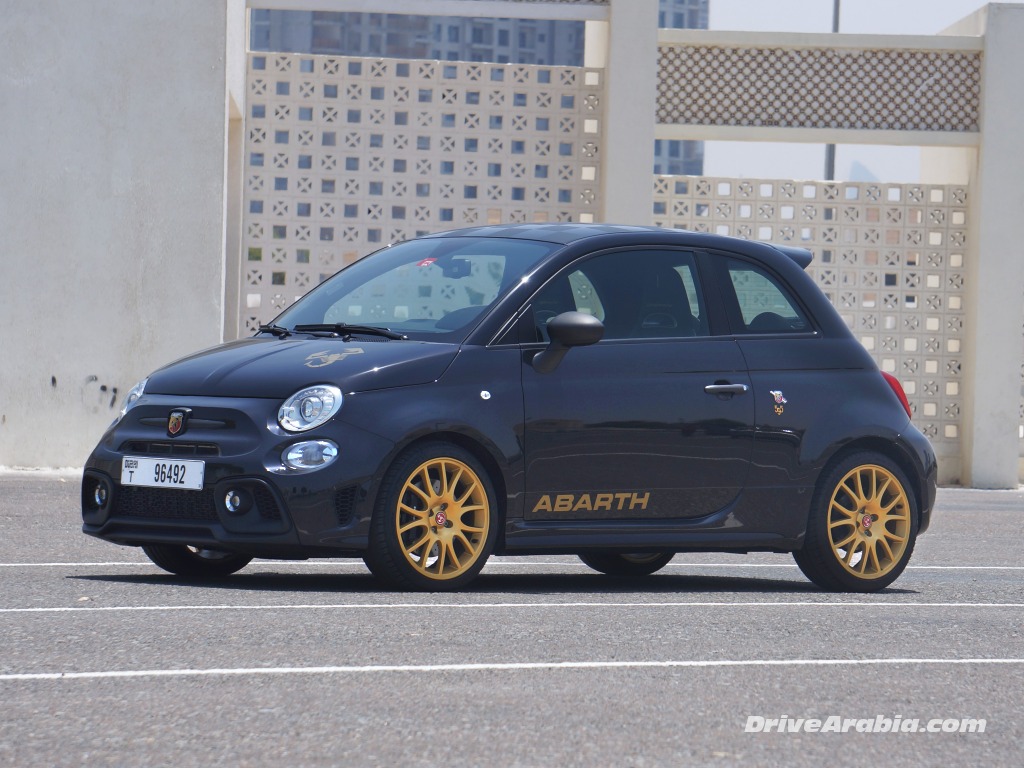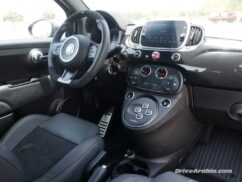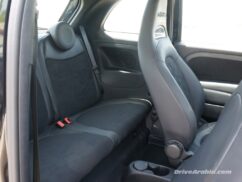2024 Abarth 595 / 695
| The Good: – Old-school charm in and out – Sounds like an animal – Extremely fun to drive |
The Bad: – Harsh ride – Large turning circle – Turbo and auto-gearbox lag |
For a bit of context, the Abarth 595 you see in these pictures isn’t a 2024 model. Technically, we drove the 2022 Abarth 595 Scorpioneoro, which was a “limited edition” that simply involved some stickers, unique gold wheels and extra seat stitching. You can still buy an almost similar-looking spec in 2024, dubbed the 695 75th Anniversario. In fact, the car hasn’t really changed since it landed in the Middle East in 2018, except in terms of extraneous appearance bits. But we figured the hot little supermini needed a final hurrah in case it gets replaced in the near future by the new electric Abarth 500e.
Amazingly, the basic Fiat 500-based shell of the 595-695 duo dates back to 2006. It is a design so evergreen that it still looks relevant today, while its indirect rival, the Mini Cooper, is on its fourth generation. And you know we’re nearing the end because the 595 badge has been phased out of the Middle East market. The latest 695 range is a largely identical model, but now includes a variable “Record Monza” exhaust system.
From the outside, the Abarth somehow looks both playful yet aggressive at the same time. The distinctive scorpion badging, sporty bumpers and side decals ensure it stands out in traffic. The car boasts 17-inch alloy wheels, Brembo brakes, and quad exhaust tips, providing a hint of the performance underneath that tiny bonnet.

Stepping inside, Fiat still carries on with the same cabin design that debuted with the 2016 facelift, yet somehow it doesn’t look particularly outdated, even with the small touchscreen. The interior is largely made up of textured hard plastics, with a large section of the dash painted in body-colour. The digital gauge cluster, metal pedals, leather-wrapped armrests, some Alcantara trimmings and the well-padded handbrake handle give the car a premium feel.
Having driven versions with optional Sabelt racing seats, the standard seats in our test car were a blessing. Featuring leather and suede upholstery, the front seats come with fixed headrests and decent padding. However, space remains a constraint. The front seats are snug, making them a bit uncomfortable for “wider” occupants.
The rear seats are best suited for average-sized adults, and even then, it’s a tight fit for anyone over six feet tall. The boot space is minimal, fitting only a week’s worth of groceries, although folding the rear seats expands the cargo capacity enough to swallow up a folding mattress. Our car did not have a spare tyre.
The button-operated automatic gear selector and the UConnect multimedia system with a 7-inch touchscreen remain, with all the usual phone connectivity features and stereo controls. A rather good 6-speaker 480W Beats Audio system is available with a subwoofer in the boot. The single-zone auto a/c isn’t too bad either, at least for front passengers. And they get one USB port, next to the two floor-mounted cupholders. Rear passengers get two cupholders too, as well as adjustable headrests.
If you haven’t guessed yet, the Abarth is pretty old school in terms of tech, with a flip-key that you need to insert and twist. Once Gen Z’ers figure out how to start the car, the other features are more familiar, such as the power-window buttons on the centre console and remote locking on the key fob, aside from auto bi-xenon headlights, front and rear fog lights, rear parking sensors, ESP and a full set of airbags. There’s no rear camera though.

For as long as the Abarth has been in the Middle East, the standard engine has been the 1.4-litre turbocharged four-cylinder, good for 180 hp at 5500 rpm and 255 Nm of torque at 2250 rpm.
The punchy motor is paired with the same 5-speed automated manual gearbox. The notorious single-clutch setup still suffers from jerky shifts and sluggish responses in automatic mode. However, the paddle shifters allow for manual control, and the best experience is had by lifting off the throttle while shifting gear, just as if you were driving an actual stick-shift car. Turbo lag is very present from take-off, but once past it, the car accelerates briskly, with a pleasingly raspy exhaust note.
We managed a 0-100 kph time of 6.9 seconds during our summer afternoon testing in Dubai, which is quick enough to be fun on its own, but we wouldn’t go picking fights with Mustangs and Chargers.
Corners are a different story though. Every GCC-spec 595 and 695 features Koni FSD shock absorbers and four-piston Brembo brake calipers, with 305mm front and 240mm rear ventilated brake discs.
Armed with such top-shelf equipment, the front-wheel-drive Abarth shines when hustled in the twisties. Its compact size and sport-tuned suspension make for hours of fun on tight roads which would otherwise feel unsafe in larger rear-driven cars. There is almost non-existent body roll, and the relatively narrow 205-width tyres still provide ample grip. It’s easy to dive into turns with confidence, although at the extreme limit, it does exhibit some understeer. And if you’re a regular on the racetrack, you might yearn for something faster. The nimble Abarth is more fun on winding public roads.
The steering is precise and offers decent feedback, although the turning circle remains larger than expected for a car of this size. On the plus side, the strong brakes provide excellent stopping power, although the pedal weightage could be more substantial.
The driving dynamics, however, come at the cost of ride comfort. The stiff suspension setup translates to a harsh ride, especially at lower speeds. Potholes and road imperfections are felt more prominently, which can be tiresome over long distances. And the engine is buzzing even when cruising at the speed limit. We also burned 11 litres/100 km (9.1 km/litre) of petrol, probably because the car urges you to hammer it everywhere.
Even with all its flaws, Fiat’s little fireball is a charming throwback to when performance cars were strictly for enthusiasts, devoid of electronic-nanny overkill, and still somewhat within reach in terms of price. Heck, it still has a regular key, putting it alongside the Toyota LC70 and the Nissan Patrol Safari to still offer one new. If the old-school novelty and spritely character appeals to you, the Abarth supermini remains a delightful choice for a sporty urban runabout.
Photos by Mashfique Hussain Chowdhury.
| Price Range: Dh 119,900-145,900 Current Model Introduced in: Body Styles: Engines: Transmissions: Setup: Suspension: |
Brakes: Front: discs Rear: discs Curb Weight: Length: Wheelbase: Top Speed: Test Acceleration 0-100 kph: Observed Test Fuel Economy: |
















There are no comments. Be the first!